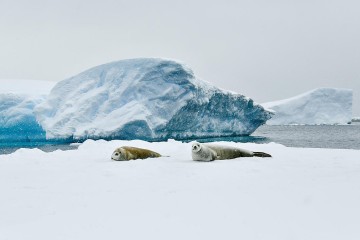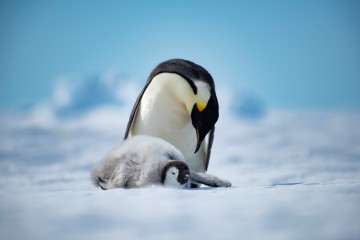Helicopter operations in Antarctica are acutely weather-dependent. We have designed this itinerary so we can spend time each day in stunning locations that allow us to enjoy helicopter opportunities if the weather allows and, alternately, to maximize your experience of Antarctic wildlife, ice and landscapes when flying conditions are not favorable. Each day on the Antarctic Peninsula will showcase the flexibility and technical prowess of our industry-leading expedition team, pilots and crew.
As Ultramarine gains access to the Antarctic Peninsula, our team will look for opportunities to experience Antarctica beyond the coast and over the expansive glacial terrain of the last great wilderness.
Together, Antarctic Sound, Erebus and Terror Gulf, northwestern Weddell Sea are the theater of this venture. Initially we plan to sail into Antarctic Sound where we will visit two towering geological features:
Madder Cliffs on Joinville Island, and Brown Bluff on the most northerly tip of the Antarctic Continent. Our goal is to visit large Adélie penguin colonies in this area by Zodiac. Gentoo penguins and seals also frequently roam this coast. There will be time to marvel at the impressive topography, namely the 678 meter (2,225-foot) volcanic rock cliffs at Brown Bluff- though, if weather allows, we may pivot from our marine operations and embark on our first flightseeing experience of the voyage. What you will have just seen from sea, you will now experience from the sky as you gaze over the vastness of Antarctica with the perspective of a snow petrel.
Continuing through Antarctic Sound and into Erebus and Terror Gulf, located on the tip of the southeast side of the Antarctic Peninsula, Ultramarine will be positioned to maximize both helicopter and Zodiac excursions. The James Ross
Island group, which comprises several Islands, offers myriad opportunities to explore historically relevant sites that were discovered by the Swedish Antarctic Expedition of 1901-04. Upon landing, we plan to hike to a summit to view an Adélie penguin colony, as well as the northern Weddell Sea. If the tide is low, there may be grounded bergs in the shallow waters— a surreal sight you’re unlikely to encounter on many polar expeditions. These islands, highly valued for their geological significance, are home to fossil finds, ventifacts (ancient rocks polished smooth over time by wind and grains of sand) and the remains of the KT Boundary, which marks the transition between the Cretaceous Period (dinosaurs and reptiles) and the Tertiary Period (mammals). Our goal is to provide opportunities for you to see ventifacts up close, to better appreciate the significance of wind erosion-by sand or ice particles— over long periods of time. These ventifacts provide valuable information about the climatic history and prevailing wind patterns of the region.
As already mentioned, atmospheric conditions influence when and where we fly-on any day of our voyage-at any of the superb locations in the region.
When not flying, we’ll shift our focus from geology to wildlife. For instance, we could Zodiac cruise to Devil Island and head out on a hike that will allow participants to appreciate the twin towering cones of ash and hardened lava that rises from a bay on the north shore of Vega Island. Alternatively, we may aim for renowned Paulet Island, home to one of the largest Adélie penguin rookeries in the area, as well as the historic hut built by members of the Swedish Antarctic Expedition of 1901-04. A cross marks the grave site of Ole Wennersgaard, a member of the crew.
Another potential destination for helicopter operations includes the dramatic headland on the northeastern tip of Joinville island. One of the first features you’ll see as we approach the island by air is, of course, the distinct rocky headland sticking out of the rugged, icy landscape.
This prominent landmark has proven useful for navigation and exploration over the years.
Expect a dramatic finale to the helicopter-focused segment of the expedition as we prepare to return back across the Drake Passage. While our team has devised multiple back-up plans-crucial on any polar expedition- our ultimate goal at this point is a heli flightseeing excursion to Livingston Island, home of the most spectacular mountains of the South Shetland Islands. Among the towering peaks you’ll see from air are the Tangra Mountains (stretching 32 kilometres long by 8.5 kilometres wide), Mount Friesland (rising to 1,700 metres/ 5,578 feet) , Bowles Ridge and Pliska Ridge (667 metres/2,188 feet).
Another landing option is Deception Island. Along with waddling penguins and lounging seals, you can also see the rusting remnants of long-ago whaling operations on the beach. The landscape of Deception Island often presents opportunities for longer walks to striking vistas. The stark contrast between snow and dark volcanic sand, and the geothermic steam along the shoreline gives this location an atmospheric feel.



